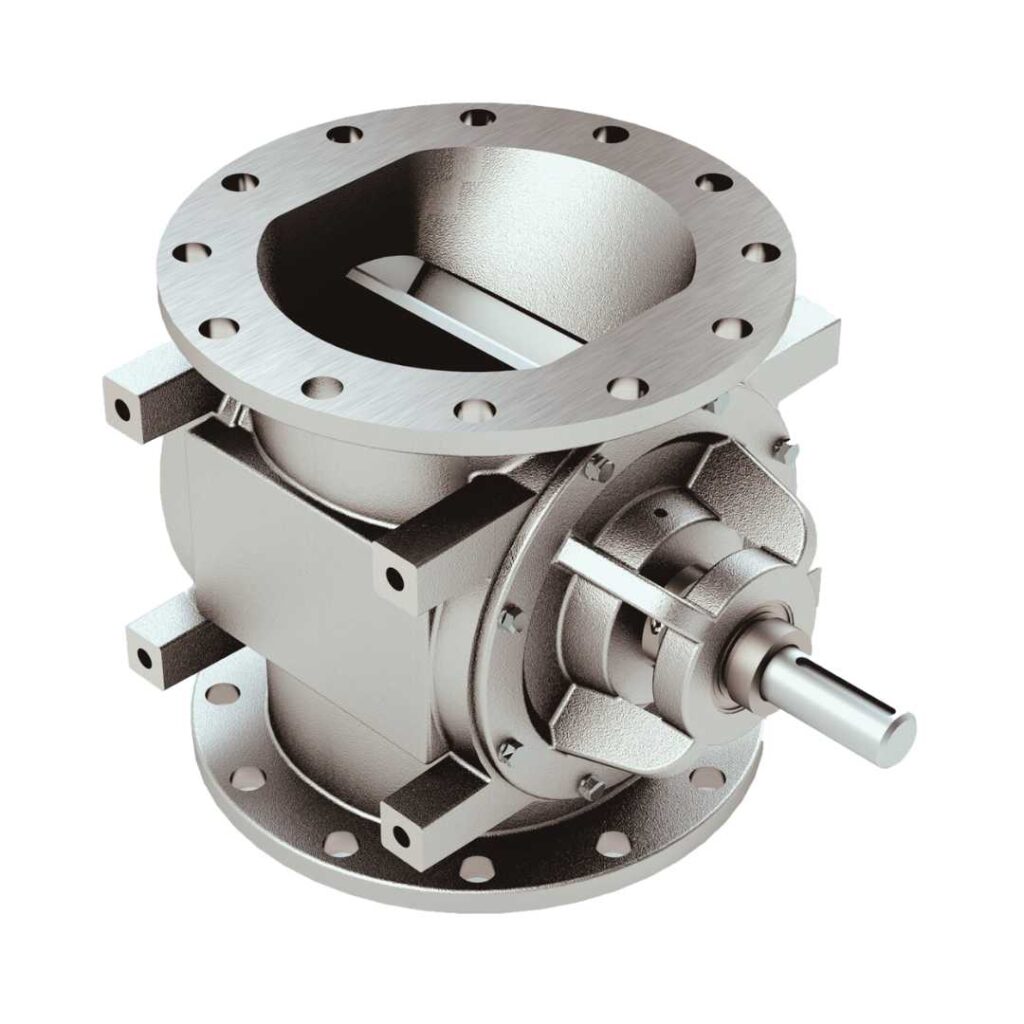In pneumatic conveying and bulk material handling systems, maintaining consistent air pressure and material flow is essential. This is where the air rotary valve, also known as a rotary airlock valve or rotary feeder valve, plays a critical role.

These valves act as both a flow control and sealing device, allowing material to pass between areas of differing pressure—typically between a hopper, silo, or dust collector and a pneumatic conveying line.
Table of Contents
Toggle1. What Is an Air Rotary Valve?
An air rotary valve (or rotary airlock) is a mechanical device that regulates the flow of dry bulk materials—such as powders, granules, or pellets—while maintaining an airtight seal between two different pressure zones.
It consists of a rotating rotor with multiple vanes (or blades) inside a cylindrical housing. As the rotor turns, it captures material from an inlet and releases it through the outlet, preventing air leakage in pneumatic systems.
Common Names
Rotary Airlock Valve
Airlock Rotary Valve
Rotary Feeder Valve
Rotary Air Lock
Rotary Air Valve
All these names refer to the same equipment with slightly different design focuses depending on the industry.
2. Working Principle of a Rotary Airlock Valve
The rotary airlock valve works on a simple yet precise principle of airlock feeding:
Feeding: Material falls by gravity into the pockets between the rotor blades.
Rotation: The rotor turns at a controlled speed, carrying material to the outlet side.
Discharge: As the rotor continues to rotate, the pockets release the material into the downstream process.
Airlock Function: Throughout the rotation, the valve maintains a tight seal between high-pressure and low-pressure zones, preventing air or gas leakage.
This design allows for continuous, uniform feeding of materials without disturbing the air pressure in the conveying system.
3. Key Components of a Rotary Air Valve
| Component | Function |
|---|---|
| Rotor | The rotating element that carries and discharges material. Usually made of stainless steel or cast iron. |
| Housing/Body | Encloses the rotor and forms the airtight chamber. |
| End Covers | Support the rotor shaft and house bearings and seals. |
| Seals & Bearings | Prevent air and material leakage from the sides. |
| Drive Unit | Electric motor and gearbox that control the rotor’s speed and torque. |
Advanced designs may include adjustable clearances, replaceable wear plates, and purged shaft seals for handling abrasive or sticky materials.
4. Common Types of Rotary Airlock Valves
Rotary valves come in various configurations depending on the material type, pressure, and temperature of operation.
(1) Drop-Through Rotary Valve
The most common design — material drops directly through the housing as the rotor turns. Ideal for dust collection and gravity feeding systems.
(2) Blow-Through Rotary Valve
Used in pneumatic conveying. The conveying line passes through the rotor, allowing air to carry material directly into the pipeline.
(3) Heavy-Duty Rotary Valve
Built with abrasion-resistant materials (e.g., Ni-hard or chrome-plated steel) for handling abrasive bulk solids like cement, sand, or minerals.
(4) Sanitary or Quick-Clean Rotary Valve
Used in food, pharmaceutical, or chemical industries, where easy disassembly and cleaning are required.
5. Industrial Applications
Air rotary valves are indispensable in many bulk handling and pneumatic systems across industries:
| Industry | Application |
|---|---|
| Cement & Mining | Feeding and discharging powders, limestone, fly ash, and minerals. |
| Power Generation | Handling fly ash and fuel dust in conveying systems. |
| Food & Beverage | Controlling the flow of flour, sugar, grains, or spices. |
| Pharmaceutical | Metered feeding of active ingredients and powders. |
| Chemical Processing | Managing plastic pellets, resins, and catalysts. |
| Waste & Recycling | Discharging dust and fines from bag filters or cyclones. |
In all these cases, rotary airlocks help maintain steady material flow, prevent air loss, and protect system pressure balance.
6. Advantages of Rotary Airlock Valves
✅ Maintains System Pressure — Prevents air leakage between pressure zones.
✅ Consistent Material Feed — Ensures even discharge of bulk materials.
✅ Compact and Reliable — Simple design with low maintenance needs.
✅ Customizable — Available in various materials, coatings, and sizes.
✅ Versatile Applications — Suitable for both gravity and pneumatic systems.
7. Key Considerations When Selecting a Rotary Air Valve
When choosing the right rotary feeder valve, consider the following factors:
Material Characteristics — Particle size, temperature, abrasiveness, and moisture content.
System Pressure — Differential pressure between inlet and outlet.
Capacity Requirements — Rotor volume and speed determine throughput.
Seal Type — Choose between gland seals, air-purged seals, or mechanical seals depending on air leakage tolerance.
Construction Material — Cast iron, stainless steel, or special alloys based on chemical compatibility.
Proper sizing and selection ensure long service life and optimal airlock performance.
8. Rotary Valve Maintenance and Safety Tips
Regularly inspect rotor clearance and seal condition.
Lubricate bearings according to the manufacturer’s schedule.
Avoid operating the valve empty for extended periods to prevent wear.
Keep spare seals and bearings for quick maintenance.
Always depressurize the system before inspection or cleaning.
9. Conclusion
The air rotary valve—also known as a rotary airlock valve, rotary feeder valve, or rotary air valve—is an essential component in modern bulk material handling systems. Its ability to control material flow and maintain pressure separation makes it indispensable in pneumatic conveying, dust collection, and process automation applications.
Whether for mining, food processing, power plants, or chemical industries, a properly designed and maintained rotary airlock ensures efficiency, safety, and reliability.
If you’re looking for industrial-grade airlock rotary valves or custom rotary feeders, TOT Valve & Flow Control offers a wide range of high-performance designs—engineered for durability, precision, and superior sealing performance.
👉 Contact us today to request specifications or a quotation for your next pneumatic conveying project.
